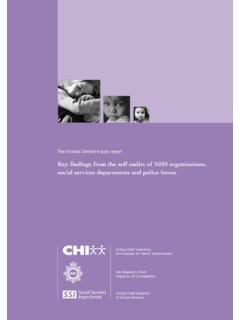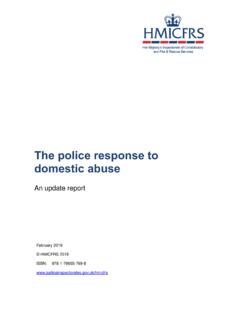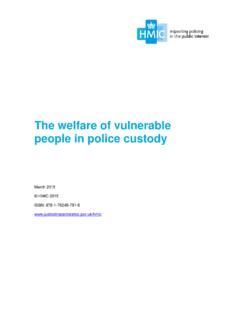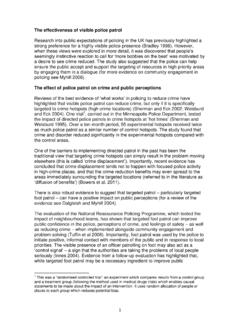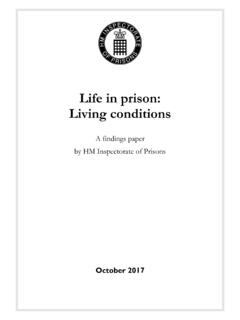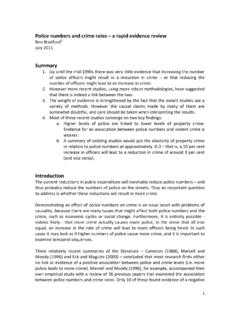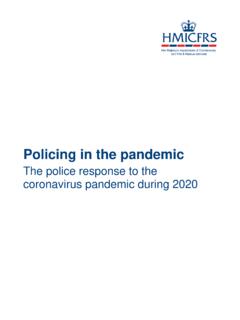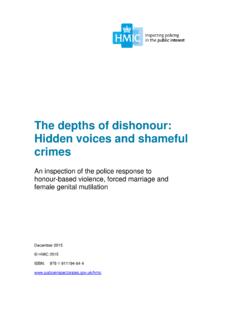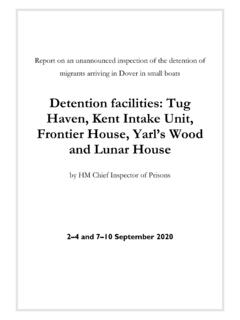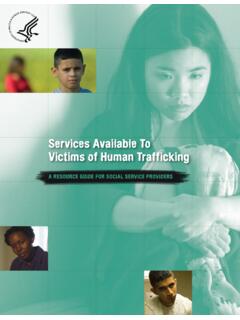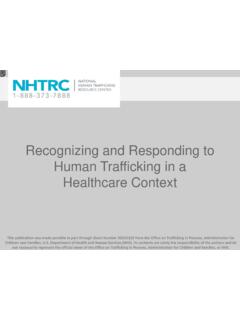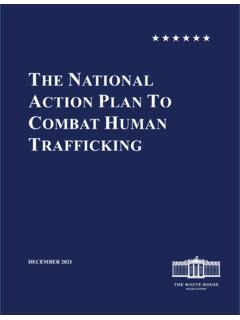Transcription of Stolen freedom: the policing response to modern slavery ...
1 Stolen freedom: the policing response to modern slavery and human trafficking October 2017 HMICFRS 2017 ISBN: 978-1-78655-579-3 2 Contents Foreword .. 5 Summary .. 7 1. Introduction .. 15 About modern slavery and human trafficking .. 15 Our inspection methodology .. 17 2. Context: Recent developments in the national response to modern slavery and human trafficking .. 19 National Referral Mechanism (NRM) .. 19 modern slavery Strategy .. 20 modern slavery Act 2015 .. 21 Haughey Review of the modern slavery Act .. 23 Police Transformation Programme .. 24 National priority threat .. 25 Work and Pensions Committee report on victims of modern slavery .. 25 Summary .. 26 3. Findings: Leadership .. 27 National police leadership .. 27 NCA 28 Regional leadership .. 30 Force leadership .. 31 Police and crime commissioners .. 33 4. Findings: Intelligence .. 34 National intelligence picture .. 34 Use of intelligence from the NRM.
2 35 Regional intelligence picture .. 36 3 Local intelligence picture .. 36 Co-ordination between the NCA, ROCUs and forces .. 39 Partnership working .. 39 5. Findings: Victim identification and initial response .. 41 Contact officers .. 41 NRM referrals .. 46 Duty to Notify submissions .. 50 6. Findings: Crime recording .. 53 Findings from the crime data integrity inspection .. 54 Findings from this inspection .. 56 7. Findings: Investigations .. 60 NCA investigations .. 60 ROCUs .. 61 Force investigations .. 61 Working across boundaries .. 68 8. Findings: Victim care .. 70 NCA and ROCUs .. 70 Victim care plans .. 71 Accommodation for victims .. 72 Work with victim support charities .. 72 Maintaining contact when victims relocate .. 73 9. Findings: Prevention and disruption .. 75 NCA and ROCUs .. 75 Forces .. 75 Use of preventative powers .. 78 10. Training .. 79 National training and guidance .. 79 4 NCA and ROCUs.
3 80 Forces .. 80 11. Conclusion .. 82 Recommendations .. 85 Definitions and interpretation .. 88 Annex A HMICFRS modern slavery and human trafficking expert reference group .. 102 Annex B Fieldwork methodology .. 104 5 Foreword In the UK, today and every day, thousands of men, women and children who are victims of modern slavery and human trafficking are being degraded and dehumanised. These crimes are multi-faceted. Cases may involve single or multiple offenders or victims , and may be national or international, organised or opportunistic. They occur in both rural and metropolitan areas, in settings ranging from nail bars to construction sites, and involve activities from domestic servitude to the trafficking of children for sexual exploitation. It is imperative that police forces are aware of the signs and indicators of these most pernicious and frequently hidden of crimes so that they can respond in an appropriate manner.
4 In this inspection we examined how the police in England and Wales are tackling modern slavery and human trafficking crimes, including their use of the powers and provisions set out in the modern slavery Act 2015. We interviewed national leads from different agencies, examined a wide range of documentation and data, and assessed operational practice in police forces, regional organised crime units (ROCUs) and within the National Crime Agency (NCA). We are grateful to all those who have contributed to the inspection and informed our work. In particular, we would like to thank the Independent Anti- slavery Commissioner (Kevin Hyland OBE) and the National Police Chiefs' Council lead (Chief Constable Shaun Sawyer), together with their respective offices, for sharing much useful information and analysis; the Home Office's modern slavery Unit; and barrister Caroline Haughey for her valuable insights and support throughout the inspection.
5 We found clear evidence of a growing impetus at national and regional levels to improve the law enforcement response to modern slavery and human trafficking . Some forces Greater Manchester Police in particular are leading the way in this, and show how commitment and dedication to dealing with this type of crime can produce effective results. Overall, however, the inspection found that the identification of victims is inconsistent, sometimes ineffective, and in need of urgent and significant improvement. victims who come into contact with the police are not always recognised as such and therefore remain in the hands of those who are exploiting them. Others are arrested as offenders or illegal immigrants. While law enforcement has a duty to refer individuals to immigration and enforcement, the vulnerability of victims must be considered in parallel. Our review of current and recent cases of modern slavery and human trafficking in our ten fieldwork forces also raises serious concerns about the quality of investigations.
6 We found that investigations are being closed prematurely, with lines 6 of enquiry still open. In some cases, victims and witnesses were not even spoken to by the police. As a result of these failings, victims are left unprotected while offenders are not brought to justice, leaving them free to continue to exploit people as commodities. Too much police work in this area is reactive, showing little understanding of the nature and scale of modern slavery and human trafficking . It was disappointing to find that some frontline officers did not consider modern slavery to be an issue in their force area. We were also concerned to encounter some neighbourhood officers who said that they avoided raising the issue of modern slavery and human trafficking with local communities because they did not believe the public were either interested in or sympathetic to victims of these crimes. Police forces must engage better, both internally with their own staff and externally with their local communities, to improve awareness and understanding of these abhorrent crimes.
7 Also, we found that the co-ordination and sharing of information and intelligence about modern slavery and human trafficking between the NCA and forces needs to be more consistent and timely. While we are encouraged by some more recent changes within the NCA, and acknowledge the further activity which has occurred in the interim, at the time of our inspection fieldwork these were not yet universally recognised by forces. We were also told that there were opportunities for the NCA to exploit and disseminate information and intelligence more quickly to forces to enable them to respond effectively to victims in their areas, and found evidence of this in our case file audit. Given that this kind of offending has no respect for force, national or indeed international boundaries, it is crucial that the relationship and co-ordination between the national, regional and local levels is positive and effective. Overall, while progress has been made, and we acknowledge the major developments in operations and strategy both over the course of and since our inspection, we found that the police service has much to do if it is to develop an effective, coherent and consistent response to modern slavery and human trafficking .
8 This inspection serves to establish a benchmark to enable policing at a national, regional and local level to address the spectrum of issues identified in the report. 7 Summary On 28 July 2016, the Home Secretary commissioned Her Majesty s Inspectorate of Constabulary and Fire & Rescue Services1 to inspect the police s response to the implementation of the modern slavery Act 2015 in England and Wales. This report sets out the findings from our inspection and recommendations for improvement. modern slavery and human trafficking takes many forms, but all of them involve coercion and result in the erosion of individual volition and freedom. victims may be forced into work, sex, domestic servitude or other forms of exploitation, suffering inhumane and degrading treatment for long periods of time. They are often subjected to threats or violence, which may also extend to those close to them. Government estimates2 previously suggested there were between 10,000 and 13,000 potential victims of modern slavery and human trafficking in the UK in 2013.
9 However, the true number is likely to be far higher,3 because many victims are unable or reluctant to engage with authorities (or may not be recognised as victims of this kind of offending if they do) and may be moved frequently across geographical boundaries. While the plight of victims remains unseen and unresolved, offenders can and will continue to exploit them. 1 This inspection was carried out before 19 July 2017, when HMIC took on responsibility for fire & rescue service inspections and was renamed HM Inspectorate of Constabulary and Fire & Rescue Services. The methodology underpinning our inspection findings is unaffected by this change. References to HMICFRS in this report may relate to an event that happened before 19 July 2017 when HMICFRS was HMIC. Citations of documents which HMIC published before 19 July 2017 will still cite HMIC as the publisher. 2 modern slavery Strategy, HM Government, 2014, page 5.
10 Available from: 3 See, for instance, the press release issued by the NCA on 10 August 2017, in which the Director of Vulnerabilities, Will Kerr, is quoted as saying: The growing body of evidence we are collecting points to the scale [of modern slavery in the UK] being far larger than anyone had previously thought.' 'Law enforcement steps up response to modern slavery ', press release issued by the NCA, 10 August 2017. Available from - modern - slavery 8 modern slavery Act 2015 The modern slavery Act 2015 aims to provide the legislative framework to equip law enforcement agencies effectively to prosecute and convict the perpetrators of modern The Act consolidated and simplified previous slavery and human trafficking legislation in England and Wales into a single statute, and introduced provisions to strengthen law enforcement and afford better protection to victims . These provisions included: a statutory defence for victims who commit crimes under compulsion5 (the section 45 defence); a specific duty for public authorities (including all police forces) to notify the Home Office of any individual encountered who they believe is a suspected victim of modern slavery or human trafficking (the Duty to Notify); and powers to restrict the activities of those deemed to pose a clear threat to others in respect of modern slavery and human trafficking offences.
